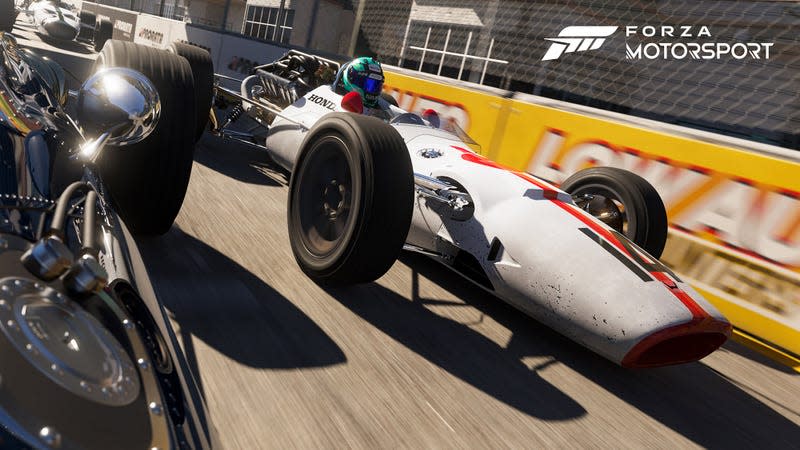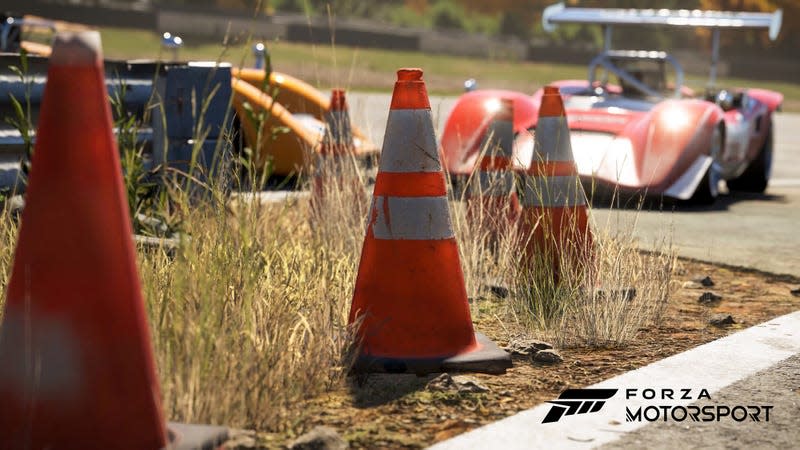How Much of Forza Motorsport Is Actually 'Built From the Ground Up?'

For the last six years, the team at Turn 10 Studios has been working to reinvent Forza Motorsport. You can argue they kind of needed this breath. Seven games, all two years apart, left the series in a rather predictable place with minimal enhancements between each rendition. Microsoft’s bid to dethrone Gran Turismo finally realized its potential with FM3, and FM4 was the zenith of that formula. The releases since haven’t necessarily been poor, but they’ve danced around core issues. 2023's Forza Motorsport represents Turn 10's best shot at putting the past to bed, once and for all.
Perhaps this is why the phrase “built from the ground up” appeared no less than four times in yesterday’s presentation during the Xbox Developer Direct showcase. First by Creative Director Chris Esaki, who attributed the expression to how the next entry “takes advantage of the Xbox Series consoles.” Then once again about the materials and shaders used for car model finishes; another time praising the audio system; and finally about the title’s 20 environments at launch. Each locale has been “built from the ground up for this generation,” per Director of Motorsport Content Arthur Shek.
Read more

Of course, every new Forza — Horizon included, but especially the sim-focused Motorsport side — touts physics improvements. Likewise, more realistic shaders, designed to accurately capture the imperfections of automotive paint, were one of the key breakthroughs that then-Creative Director, now-General Manager Dan Greenawalt promoted in Forza Motorsport 5's run up to release, in tandem with the launch of the Xbox One in 2013. When you’re pursuing a simulation, you’re never satisfied with the result; you can always get a little closer to the real artifact.
But I also remember picking up Forza Motorsport 6 in 2015 — four years and a whole console generation ahead of the last entry I’d played, FM4 — and coming away disappointed with the lack of evolution in the physics, particularly the behavior of rear-wheel-drive cars beyond the limit. It felt almost like the game was goading me into taking every corner sideways even when I didn’t want to, with lightning-quick steering only after the drive wheels began shredding themselves to bits. The lack of palpable weight transfer didn’t help things either.

Forza Horizon 5 actually delivered a sizable improvement in the latter regard, but there’s still more work to do. A new tire model will work wonders, especially if it’s as comprehensive as Esaki claimed during Thursday’s Forza Monthly stream:
[The tire model’s been] completely rebuilt. We used to have that single point of contact at 60 Hz; now we have eight points of contact per tire at 360 [Hz]. Just a huge leap in our tire model fidelity — you can feel it. It’s the core of the gameplay experience now. On top of that, the different racing tire compounds — you’ve probably seen soft, medium and hard in things like F1 — we support all of that now. Completely rebuilt suspension modeling. Weight modeling now that includes the fuel and also supports ballast adjustments that we hadn’t had before. Completely redone braking.
Does all of that constitute a true “ground-up” rebuild? Technically, if there’s any aspect of the physics code that remains from previous games — and there’s bound to be — then no it doesn’t, no matter how much better the rubber’s sampling rate is.
Therein lies the problem. Today, with games being so expensive and taking so long to make, it’s unrealistic to expect any franchise to throw away its old math. That’s simply not how it works anymore. Hand-waving away every new feature and every improvement as “fully rebuilt” is not only an exaggeration that sours trust between you and your community; it doesn’t give full respect to the very real, very tangible work that has been done, that should be pointed to and that will make the game better. Besides, as long as it feels fresh to the player, what difference does it make?

All that said, I’m willing to give Turn 10 the benefit of the doubt on physics, because that tire model will likely prove the most dramatic change to Forza’s dynamics in more than a decade. I buy the enhancements on the track side, too, considering Turn 10 went so far as to recapture data for every real-world environment that will appear in the game. As Esaki revealed on the stream, the team has even recreated historic layouts for some tracks — think Laguna Seca in the 1960s — which is super cool. Not enough games do that anymore, and frankly it’s single-handedly reignited my anticipation for Forza’s big reboot.
As for the cars, there’s reason to be skeptical. Once again, Turn 10's justification for the use of that dangerous phrase here pertains to shaders and materials. While both are crucial to the believability of any simulated scene, they don’t address the inaccuracies baked into Forza’s oldest vehicle models that have been kicking around for generations of Xbox silicon.
If you’ve been playing these games for long enough, you know what I’m talking about. Cars like the S15 Silvia, Impreza 22B STI, Golf R32 and Vauxhall Monaro. Some are more egregious than others (there are whole Reddit threads devoted to the S15) and the assets that are newer to the series have clearly been constructed to a much higher standard. But watching Wednesday’s trailer and seeing the likes of the E30 M3 and Saleen S7 look just off — in the same way they’ve looked just off since I was in high school — sort of obscures any progress on the materials side, let alone additions like the new dirt accumulation that’s bespoke to every car.

Here’s a real E30 M3...

...and here’s Forza’s 2023 version.
The E30-at-home thing is one of a handful of longstanding bugbears — from the series’ downright violent artificial intelligence to its unengaging campaigns and livery editor that was groundbreaking for 2005, but woefully antiquated compared to Gran Turismo 7's or any PC sim, where you’re free to upload whatever graphics you like. Esaki did tease new AI, which he called “authentically fast without cheats” — something you certainly would never say about GT7's computer-controlled opponents.
Likewise, there’s still so much to learn about the game’s “car building-focused single-player career.” Hopefully it’s been designed to cultivate more of a feeling of ownership than you get in Forza Horizon, where you’re thrown a fully modded C8 Corvette from the jump. No, literally — you get the car moments after yeeting a Bronco off a plane.
Many of these problems may not be fixed for Forza Motorsport; even if they aren’t, that doesn’t mean the experience is a failure. Every game is more than the sum of its parts, not defined by its most irritating quality-of-life faults. But Turn 10 aught to be really careful throwing around back-of-the-box buzzwords, lest it want to draw attention to those aspects that clearly haven’t been rebuilt from the ground up. “New” would have sufficed.
More from Jalopnik
Sign up for Jalopnik's Newsletter. For the latest news, Facebook, Twitter and Instagram.

 Yahoo Autos
Yahoo Autos 